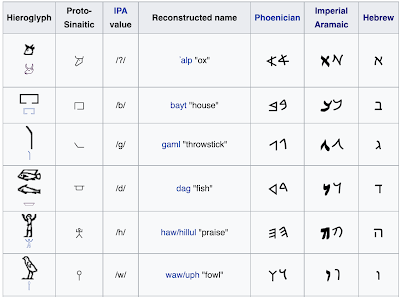It is generally accepted that the Paleo-Hebrew alphabet that the Torah was written in was derived from the ancient Egyptian Hieroglyphics via Proto-Sinaic script. The modern sounds for the glyphs often come directly from the word, for example the Hebrew ע (ayin) which means eye is derived from the ancient hieroglyph for eye 𓁹. While the shapes became totally morphed, the order and meaning is unmistakeable. Note that the ancient Egyptians likely had different phonemes for each of glyphs and a different order. But the order of this "Aleph Bet" was passed on through Phoenician to Greek and spawned off most of the written scripts in use today (including this very one: AB[C]D).
- The Hebrew came from sefira.org, Tanach with Text Only (Hebrew). text without tags.
- Processing was done in python; can be done for the other books if needed.
- I wasn't fancy enough to get the right-to-left thing working, so the text here has all the characters in backwards order.
- There is some ambiguity in the mapping for example ו (vav/upf עוף) could be 𓅱 or 𓌉. In these cases I tried to choose the cooler looking glyph.
Genesis / בראשית / 𓏴𓂝𓇴𓃾𓁶𓉐
𓇑𓁶𓃾𓀠 𓏴𓃾𓅱 𓈖𓂝𓈖𓇴𓀠 𓏴𓃾 𓈖𓂝𓀠𓋿𓃾 𓃾𓁶𓉐 𓏴𓂝𓇴𓃾𓁶𓉐
𓈖𓂝𓈖𓀠 𓂝𓆓𓂋 𓋿𓁹 𓏴𓂋𓉗𓁶𓈖 𓈖𓂝𓀠𓋿𓃾 𓉗𓅱𓁶𓅱 𓈖𓅱𓀠𓏴 𓂝𓆓𓂋 𓋿𓁹 𓂧𓇴𓉗𓅱 𓅱𓀠𓉐𓅱 𓅱𓀠𓏴 𓀠𓏴𓂝𓀠 𓇑𓁶𓃾𓀠𓅱
𓁶𓅱𓃾 𓂝𓀠𓂝𓅱 𓁶𓅱𓃾 𓂝𓀠𓂝 𓈖𓂝𓀠𓋿𓃾 𓁶𓈖𓃾𓂝𓅱
𓂧𓇴𓉗𓀠 𓆓𓂝𓉐𓅱 𓁶𓅱𓃾𓀠 𓆓𓂝𓉐 𓈖𓂝𓀠𓋿𓃾 𓋿𓆛𓉐𓂝𓅱 𓉐𓅱𓄤 𓂝𓂧 𓁶𓅱𓃾𓀠 𓏴𓃾 𓈖𓂝𓀠𓋿𓃾 𓃾𓁶𓂝𓅱
𓆛𓉗𓃾 𓈖𓅱𓂝 𓁶𓎗𓉐 𓂝𓀠𓂝𓅱 𓉐𓁶𓁹 𓂝𓀠𓂝𓅱 𓀠𓋿𓂝𓋿 𓃾𓁶𓎗 𓂧𓇴𓉗𓋿𓅱 𓈖𓅱𓂝 𓁶𓅱𓃾𓋿 𓈖𓂝𓀠𓋿𓃾 𓃾𓁶𓎗𓂝𓅱
𓈖𓂝𓈖𓋿 𓈖𓂝𓈖 𓆓𓂝𓉐 𓋿𓂝𓆛𓉐𓈖 𓂝𓀠𓂝𓅱 𓈖𓂝𓈖𓀠 𓂧𓅱𓏴𓉐 𓁹𓂝𓎗𓁶 𓂝𓀠𓂝 𓈖𓂝𓀠𓋿𓃾 𓁶𓈖𓃾𓂝𓅱
𓆓𓂧 𓂝𓀠𓂝𓅱 𓁹𓂝𓎗𓁶𓋿 𓋿𓁹𓈖 𓁶𓇴𓃾 𓈖𓂝𓈖𓀠 𓆓𓂝𓉐𓅱 𓁹𓂝𓎗𓁶𓋿 𓏴𓉗𓏴𓈖 𓁶𓇴𓃾 𓈖𓂝𓈖𓀠 𓆓𓂝𓉐 𓋿𓆛𓉐𓂝𓅱 𓁹𓂝𓎗𓁶𓀠 𓏴𓃾 𓈖𓂝𓀠𓋿𓃾 𓇴𓁹𓂝𓅱
𓂝𓆓𓇴 𓈖𓅱𓂝 𓁶𓎗𓉐 𓂝𓀠𓂝𓅱 𓉐𓁶𓁹 𓂝𓀠𓂝𓅱 𓈖𓂝𓈖𓇴 𓁹𓂝𓎗𓁶𓋿 𓈖𓂝𓀠𓋿𓃾 𓃾𓁶𓎗𓂝𓅱
𓆓𓂧 𓂝𓀠𓂝𓅱 𓀠𓇴𓉐𓂝𓀠 𓀠𓃾𓁶𓏴𓅱 𓆛𓉗𓃾 𓈖𓅱𓎗𓈖 𓋿𓃾 𓈖𓂝𓈖𓇴𓀠 𓏴𓉗𓏴𓈖 𓈖𓂝𓈖𓀠 𓅱𓅱𓎗𓂝 𓈖𓂝𓀠𓋿𓃾 𓁶𓈖𓃾𓂝𓅱
𓉐𓅱𓄤 𓂝𓂧 𓈖𓂝𓀠𓋿𓃾 𓃾𓁶𓂝𓅱 𓈖𓂝𓈖𓂝 𓃾𓁶𓎗 𓈖𓂝𓈖𓀠 𓀠𓅱𓎗𓈖𓋿𓅱 𓇑𓁶𓃾 𓀠𓇴𓉐𓂝𓋿 𓈖𓂝𓀠𓋿𓃾 𓃾𓁶𓎗𓂝𓅱
𓆓𓂧 𓂝𓀠𓂝𓅱 𓇑𓁶𓃾𓀠 𓋿𓁹 𓅱𓉐 𓅱𓁹𓁶𓈔 𓁶𓇴𓃾 𓅱𓆓𓂝𓈖𓋿 𓂝𓁶𓂋 𓀠𓇴𓁹 𓂝𓁶𓂋 𓇑𓁹 𓁹𓁶𓈔 𓁹𓂝𓁶𓈔𓈖 𓉐𓇴𓁹 𓃾𓇴𓆛 𓇑𓁶𓃾𓀠 𓃾𓇴𓆛𓏴 𓈖𓂝𓀠𓋿𓃾 𓁶𓈖𓃾𓂝𓅱
𓉐𓅱𓄤 𓂝𓂧 𓈖𓂝𓀠𓋿𓃾 𓃾𓁶𓂝𓅱 𓅱𓀠𓆓𓂝𓈖𓋿 𓅱𓉐 𓅱𓁹𓁶𓈔 𓁶𓇴𓃾 𓂝𓁶𓂋 𓀠𓇴𓁹 𓇑𓁹𓅱 𓅱𓀠𓆓𓂝𓈖𓋿 𓁹𓁶𓈔 𓁹𓂝𓁶𓈔𓈖 𓉐𓇴𓁹 𓃾𓇴𓆛 𓇑𓁶𓃾𓀠 𓃾𓇑𓅱𓏴𓅱
𓂝𓇴𓂝𓋿𓇴 𓈖𓅱𓂝 𓁶𓎗𓉐 𓂝𓀠𓂝𓅱 𓉐𓁶𓁹 𓂝𓀠𓂝𓅱
𓈖𓂝𓆓𓇴𓅱 𓈖𓂝𓈖𓂝𓋿𓅱 𓈖𓂝𓆛𓁹𓅱𓈖𓋿𓅱 𓏴𓏴𓃾𓋿 𓅱𓂝𓀠𓅱 𓀠𓋿𓂝𓋿𓀠 𓆓𓂝𓉐𓅱 𓈖𓅱𓂝𓀠 𓆓𓂝𓉐 𓋿𓂝𓆛𓉐𓀠𓋿 𓈖𓂝𓈖𓇴𓀠 𓁹𓂝𓎗𓁶𓉐 𓏴𓁶𓃾𓈖 𓂝𓀠𓂝 𓈖𓂝𓀠𓋿𓃾 𓁶𓈖𓃾𓂝𓅱
𓆓𓂧 𓂝𓀠𓂝𓅱 𓇑𓁶𓃾𓀠 𓋿𓁹 𓁶𓂝𓃾𓀠𓋿 𓈖𓂝𓈖𓇴𓀠 𓁹𓂝𓎗𓁶𓉐 𓏴𓁶𓅱𓃾𓈖𓋿 𓅱𓂝𓀠𓅱
𓈖𓂝𓉐𓂧𓅱𓂧𓀠 𓏴𓃾𓅱 𓀠𓋿𓂝𓋿𓀠 𓏴𓋿𓇴𓈖𓈖𓋿 𓆓𓄤𓎗𓀠 𓁶𓅱𓃾𓈖𓀠 𓏴𓃾𓅱 𓈖𓅱𓂝𓀠 𓏴𓋿𓇴𓈖𓈖𓋿 𓋿𓆛𓌙𓀠 𓁶𓅱𓃾𓈖𓀠 𓏴𓃾 𓈖𓂝𓋿𓆛𓌙𓀠 𓏴𓁶𓃾𓈖𓀠 𓂝𓆓𓇴 𓏴𓃾 𓈖𓂝𓀠𓋿𓃾 𓇴𓁹𓂝𓅱
𓇑𓁶𓃾𓀠 𓋿𓁹 𓁶𓂝𓃾𓀠𓋿 𓈖𓂝𓈖𓇴𓀠 𓁹𓂝𓎗𓁶𓉐 𓈖𓂝𓀠𓋿𓃾 𓈖𓏴𓃾 𓆓𓏴𓂝𓅱
𓉐𓅱𓄤 𓂝𓂧 𓈖𓂝𓀠𓋿𓃾 𓃾𓁶𓂝𓅱 𓂧𓇴𓉗𓀠 𓆓𓂝𓉐𓅱 𓁶𓅱𓃾𓀠 𓆓𓂝𓉐 𓋿𓂝𓆛𓉐𓀠𓋿𓅱 𓀠𓋿𓂝𓋿𓉐𓅱 𓈖𓅱𓂝𓉐 𓋿𓇴𓈖𓋿𓅱
𓂝𓁹𓂝𓉐𓁶 𓈖𓅱𓂝 𓁶𓎗𓉐 𓂝𓀠𓂝𓅱 𓉐𓁶𓁹 𓂝𓀠𓂝𓅱
𓈖𓂝𓈖𓇴𓀠 𓁹𓂝𓎗𓁶 𓂝𓆓𓂋 𓋿𓁹 𓇑𓁶𓃾𓀠 𓋿𓁹 𓂋𓂋𓅱𓁹𓂝 𓂋𓅱𓁹𓅱 𓀠𓂝𓉗 𓇴𓂋𓆓 𓇑𓁶𓇴 𓈖𓂝𓈖𓀠 𓅱𓇑𓁶𓇴𓂝 𓈖𓂝𓀠𓋿𓃾 𓁶𓈖𓃾𓂝𓅱
𓉐𓅱𓄤 𓂝𓂧 𓈖𓂝𓀠𓋿𓃾 𓃾𓁶𓂝𓅱 𓅱𓀠𓆓𓂝𓈖𓋿 𓂋𓆓𓂧 𓂋𓅱𓁹 𓋿𓂧 𓏴𓃾𓅱 𓈖𓀠𓆓𓂝𓈖𓋿 𓈖𓂝𓈖𓀠 𓅱𓇑𓁶𓇴 𓁶𓇴𓃾 𓏴𓇴𓈖𓁶𓀠 𓀠𓂝𓉗𓀠 𓇴𓂋𓆓 𓋿𓂧 𓏴𓃾𓅱 𓈖𓂝𓋿𓆛𓌙𓀠 𓈖𓆓𓂝𓆓𓏴𓀠 𓏴𓃾 𓈖𓂝𓀠𓋿𓃾 𓃾𓁶𓉐𓂝𓅱
𓇑𓁶𓃾𓉐 𓉐𓁶𓂝 𓂋𓅱𓁹𓀠𓅱 𓈖𓂝𓈖𓂝𓉐 𓈖𓂝𓈖𓀠 𓏴𓃾 𓅱𓃾𓋿𓈖𓅱 𓅱𓉐𓁶𓅱 𓅱𓁶𓂋 𓁶𓈖𓃾𓋿 𓈖𓂝𓀠𓋿𓃾 𓈖𓏴𓃾 𓂧𓁶𓉐𓂝𓅱
𓂝𓇴𓂝𓈖𓉗 𓈖𓅱𓂝 𓁶𓎗𓉐 𓂝𓀠𓂝𓅱 𓉐𓁶𓁹 𓂝𓀠𓂝𓅱
𓆓𓂧 𓂝𓀠𓂝𓅱 𓀠𓆓𓂝𓈖𓋿 𓇑𓁶𓃾 𓅱𓏴𓂝𓉗𓅱 𓇴𓈖𓁶𓅱 𓀠𓈖𓀠𓉐 𓀠𓆓𓂝𓈖𓋿 𓀠𓂝𓉗 𓇴𓂋𓆓 𓇑𓁶𓃾𓀠 𓃾𓇑𓅱𓏴 𓈖𓂝𓀠𓋿𓃾 𓁶𓈖𓃾𓂝𓅱
𓉐𓅱𓄤 𓂝𓂧 𓈖𓂝𓀠𓋿𓃾 𓃾𓁶𓂝𓅱 𓅱𓀠𓆓𓂝𓈖𓋿 𓀠𓈖𓆛𓃾𓀠 𓇴𓈖𓁶 𓋿𓂧 𓏴𓃾𓅱 𓀠𓆓𓂝𓈖𓋿 𓀠𓈖𓀠𓉐𓀠 𓏴𓃾𓅱 𓀠𓆓𓂝𓈖𓋿 𓇑𓁶𓃾𓀠 𓏴𓂝𓉗 𓏴𓃾 𓈖𓂝𓀠𓋿𓃾 𓇴𓁹𓂝𓅱
𓇑𓁶𓃾𓀠 𓋿𓁹 𓇴𓈖𓁶𓀠 𓇴𓈖𓁶𓀠 𓋿𓂧𓉐𓅱 𓇑𓁶𓃾𓀠 𓋿𓂧𓉐𓅱 𓀠𓈖𓀠𓉐𓉐𓅱 𓈖𓂝𓈖𓇴𓀠 𓂋𓅱𓁹𓉐𓅱 𓈖𓂝𓀠 𓏴𓌙𓆛𓉐 𓅱𓆛𓁶𓂝𓅱 𓅱𓆓𓏴𓅱𓈖𓆛𓂧 𓅱𓆓𓈖𓋿𓇑𓉐 𓈖𓆛𓃾 𓀠𓇴𓁹𓆓 𓈖𓂝𓀠𓋿𓃾 𓁶𓈖𓃾𓂝𓅱
𓈖𓏴𓃾 𓃾𓁶𓉐 𓀠𓉐𓎗𓆓𓅱 𓁶𓂧𓈔 𓅱𓏴𓃾 𓃾𓁶𓉐 𓈖𓂝𓀠𓋿𓃾 𓈖𓋿𓇑𓉐 𓅱𓈖𓋿𓇑𓉐 𓈖𓆛𓃾𓀠 𓏴𓃾 𓈖𓂝𓀠𓋿𓃾 𓃾𓁶𓉐𓂝𓅱
𓇑𓁶𓃾𓀠 𓋿𓁹 𓏴𓇴𓈖𓁶𓀠 𓀠𓂝𓉗 𓋿𓂧𓉐𓅱 𓈖𓂝𓈖𓇴𓀠 𓂋𓅱𓁹𓉐𓅱 𓈖𓂝𓀠 𓏴𓌙𓆛𓉐 𓅱𓆛𓁶𓅱 𓀠𓇴𓉐𓂧𓅱 𓇑𓁶𓃾𓀠 𓏴𓃾 𓅱𓃾𓋿𓈖𓅱 𓅱𓉐𓁶𓅱 𓅱𓁶𓂋 𓈖𓂝𓀠𓋿𓃾 𓈖𓀠𓋿 𓁶𓈖𓃾𓂝𓅱 𓈖𓂝𓀠𓋿𓃾 𓈖𓏴𓃾 𓂧𓁶𓉐𓂝𓅱
𓀠𓋿𓂧𓃾𓋿 𓀠𓂝𓀠𓂝 𓈖𓂧𓋿 𓁹𓁶𓈔 𓁹𓁶𓈔 𓇑𓁹 𓂝𓁶𓂋 𓅱𓉐 𓁶𓇴𓃾 𓇑𓁹𓀠 𓋿𓂧 𓏴𓃾𓅱 𓇑𓁶𓃾𓀠 𓋿𓂧 𓂝𓆓𓂋 𓋿𓁹 𓁶𓇴𓃾 𓁹𓁶𓈔 𓁹𓁶𓈔 𓉐𓇴𓁹 𓋿𓂧 𓏴𓃾 𓈖𓂧𓋿 𓂝𓏴𓏴𓆓 𓀠𓆓𓀠 𓈖𓂝𓀠𓋿𓃾 𓁶𓈖𓃾𓂝𓅱
𓆓𓂧 𓂝𓀠𓂝𓅱 𓀠𓋿𓂧𓃾𓋿 𓉐𓇴𓁹 𓎗𓁶𓂝 𓋿𓂧 𓏴𓃾 𓀠𓂝𓉗 𓇴𓂋𓆓 𓅱𓉐 𓁶𓇴𓃾 𓇑𓁶𓃾𓀠 𓋿𓁹 𓇴𓈖𓅱𓁶 𓋿𓂧𓋿𓅱 𓈖𓂝𓈖𓇴𓀠 𓂋𓅱𓁹 𓋿𓂧𓋿𓅱 𓇑𓁶𓃾𓀠 𓏴𓂝𓉗 𓋿𓂧𓋿𓅱
𓂝𓇴𓇴𓀠 𓈖𓅱𓂝 𓁶𓎗𓉐 𓂝𓀠𓂝𓅱 𓉐𓁶𓁹 𓂝𓀠𓂝𓅱 𓆛𓃾𓈖 𓉐𓅱𓄤 𓀠𓆓𓀠𓅱 𓀠𓇴𓁹 𓁶𓇴𓃾 𓋿𓂧 𓏴𓃾 𓈖𓂝𓀠𓋿𓃾 𓃾𓁶𓂝𓅱


